
Dimetrodon is an extinct genus of non-mammalian synapsid belonging to the family Sphenacodontidae that lived during the Cisuralian age of the Early Permian period, around 295–272 million years ago. With most species measuring 1.7–4.6 m (5.6–15.1 ft) long and weighing 28–250 kg (62–551 lb), the most prominent feature of Dimetrodon is the large neural spine sail on its back formed by elongated spines extending from the vertebrae. It was an obligate quadruped and had a tall, curved skull with large teeth of different sizes set along the jaws. Most fossils have been found in the Southwestern United States, the majority of these coming from a geological deposit called the Red Beds of Texas and Oklahoma. More recently, its fossils have also been found in Germany and over a dozen species have been named since the genus was first erected in 1878.
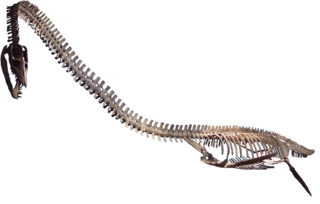
Elasmosaurus is a genus of plesiosaur that lived in North America during the Campanian stage of the Late Cretaceous period, about 80.5 million years ago. The first specimen was discovered in 1867 near Fort Wallace, Kansas, US, and was sent to the American paleontologist Edward Drinker Cope, who named it E. platyurus in 1868. The generic name means "thin-plate reptile", and the specific name means "flat-tailed". Cope originally reconstructed the skeleton of Elasmosaurus with the skull at the end of the tail, an error which was made light of by the paleontologist Othniel Charles Marsh, and became part of their "Bone Wars" rivalry. Only one incomplete Elasmosaurus skeleton is definitely known, consisting of a fragmentary skull, the spine, and the pectoral and pelvic girdles, and a single species is recognized today; other species are now considered invalid or have been moved to other genera.

Eohippus is an extinct genus of small equid ungulates. The only species is E. angustidens, which was long considered a species of Hyracotherium. Its remains have been identified in North America and date to the Early Eocene.
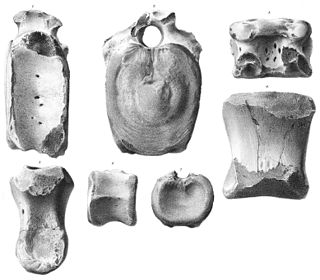
Thespesius is a dubious genus of hadrosaurid dinosaur from the late Maastrichtian-age Upper Cretaceous Lance Formation of South Dakota.

Cionodon is a dubious genus of hadrosaurid dinosaur from the Late Cretaceous. The type species, C. arctatus, was found in the Denver Formation of Lodge Pole Creek, Colorado and was formally described by Edward Drinker Cope in 1874 based on the holotype AMNH 3951, collected in 1873. It is a nomen dubium because it is based on very fragmentary remains. Two other species have since been described: Cionodon kysylkumensis, based on the holotype CCMGE 1/3760 from Uzbekistan, and Cionodon stenopsis, discovered in rocks from the Judith River Formation of Alberta, Canada in 1874. Although both are probably hadrosaurs, they are known only from fragmentary remains and Cionodon kysylkumensis has since been reclassified as Bactrosaurus kysylkumensis.

Pneumatoarthrus is an extinct genus of sea turtle known from the Late Cretaceous Mount Laurel Formation of Monmouth County, New Jersey. Only a single species, P. peloreus, is known.
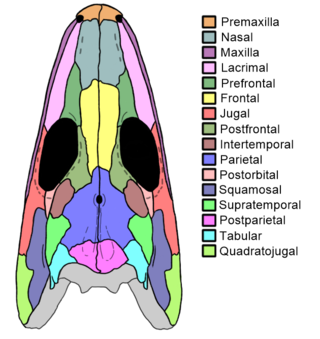
Proterogyrinus is an extinct genus of early tetrapods from the order Embolomeri. Fossil remains of Proterogyrinus have been found in Scotland, UK, and West Virginia, United States, and date back to the Serpukhovian, which is from about 331 to 323 million years ago. The genus was originally named by renowned vertebrate paleontologist Alfred Sherwood Romer in 1970. A comprehensive redescription was later published by Canadian paleontologist Robert Holmes in 1984. The generic name "Proterogyrinus" is Greek for "earlier wanderer" or "earlier tadpole". This name was chosen by Romer in keeping with a trend of naming long-bodied early tetrapods with the suffix "-gyrinus".

Protosphyraena is a fossil genus of swordfish-like marine fish, that thrived worldwide during the Upper Cretaceous Period (Coniacian-Maastrichtian). Though fossil remains of this taxon have been found in both Europe and Asia, it is perhaps best known from the Smoky Hill Member of the Niobrara Chalk Formation of Kansas. Protosphyraena was a large fish, averaging 2–3 metres in length. Protosphyraena shared the Cretaceous oceans with aquatic reptiles, such as mosasaurs and plesiosaurs, as well as with many other species of extinct predatory fish. The name Protosphyraena is a combination of the Greek word protos ("early") plus Sphyraena, the genus name for barracuda, as paleontologists initially mistook Protosphyraena for an ancestral barracuda. Recent research shows that the genus Protosphyraena is not at all related to the true swordfish-family Xiphiidae, but belongs to the extinct family Pachycormidae.

Embolomeri is an order of tetrapods or stem-tetrapods, possibly members of Reptiliomorpha. Embolomeres first evolved in the Early Carboniferous (Mississippian) Period and were the largest and most successful predatory tetrapods of the Late Carboniferous (Pennsylvanian) Period. They were specialized semiaquatic predators with long bodies for eel-like undulatory swimming. Embolomeres are characterized by their vertebral centra, which are formed by two cylindrical segments, the pleurocentrum at the rear and intercentrum at the front. These segments are equal in size. Most other tetrapods have pleurocentra and intercentra which are drastically different in size and shape.
Rhabdopelix is a dubious genus of possible kuehneosaurid reptile, from the Late Triassic-age Lockatong Formation of Pennsylvania, United States. Based on partial, possibly chimeric remains, it was described by American naturalist and paleontologist Edward Drinker Cope as an early pterosaur. It held this status until the 1960s, when Ned Colbert reevaluated it for his description of Icarosaurus. He noted that the bones came from a block with the remains of other animals, and that Cope had misinterpreted some of the remains; for example, the rod-like "pubic bones" that had given it its name were actually much more like the bony structures used by Icarosaurus and related animals to glide. Additionally, he couldn't relocate the fossils, which are assumed to be lost. He recommended considering Rhabdopelix a dubious name. Peter Wellnhofer retained it as a pterosaur of unknown affinities in his 1978 review, but rejected this by 1991.

Archeria is a genus of embolomere which lived in the Early Permian of Texas and Oklahoma. It was a medium-sized aquatic predator, with an elongated body and tail. The limbs were proportionally small but well-developed, connected to robust limb girdles. The skull was moderately long and low, up to 30 cm in length. Unlike most embolomeres, Archeria had many small chisel-shaped teeth instead of large fangs.

Diplovertebron is an extinct genus of embolomere that lived in the Late Carboniferous period (Moscovian), about 310 million years ago. Diplovertebron was a medium-sized animal, around 50 cm in length. Members of the genus inhabited European Carboniferous swamps in what is now the Czech Republic. They were closely related to larger swamp-dwelling tetrapods like Proterogyrinus and Anthracosaurus. However, Diplovertebron were much smaller than these large, crocodile-like creatures. Known from a single species, Diplovertebron punctatum, this genus has had a complicated history closely tied to Gephyrostegus, another genus of small, reptile-like amphibians.

Stegops is an extinct genus of euskelian temnospondyl from the Late Carboniferous of the eastern United States. Fossils are known from the Pennsylvanian coal deposits of Linton, Ohio. It was once classified in the eryopoid family Zatrachydidae because it and other zatrachydids have spikes extending from the margins of its skull, but it is now classified as a dissorophoid that independently evolved spikes. Stegops was first named by American paleontologist Edward Drinker Cope in 1885, with his description of the type species Stegops divaricata. Cope had also named a species of Sauropleura from Linton in 1875, which he called Sauropleura newberryi. This species was later synonymized with Stegops divaricata when the type specimen of S. newberryi was prepared and found to be a large specimen of Stegops.
Paleontology or palaeontology is the study of prehistoric life forms on Earth through the examination of plant and animal fossils. This includes the study of body fossils, tracks (ichnites), burrows, cast-off parts, fossilised feces (coprolites), palynomorphs and chemical residues. Because humans have encountered fossils for millennia, paleontology has a long history both before and after becoming formalized as a science. This article records significant discoveries and events related to paleontology that occurred or were published in the year 1877.

Archeria is a small genus of shrubs in the family Ericaceae. As currently circumscribed the group includes six species, all native to southern Australasia. Four of these are endemic to Tasmania, and the other two endemic to New Zealand.
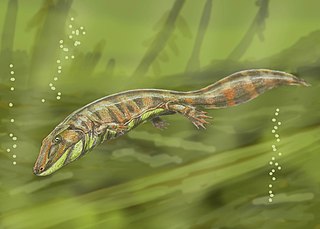
Baphetoidea is a superfamily of stem-tetrapods. It includes the family Baphetidae and several more basal genera such as Eucritta and Spathicephalus. The superfamily has also been called Loxommatoidea, but this name is a junior synonym of Baphetoidea.

Archeria hirtella is a species of shrub in the family Ericaceae. It is native to Tasmania, Australia.
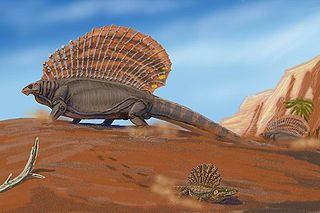
The Red Beds of Texas and Oklahoma are a group of Early Permian-age geologic strata in the southwestern United States cropping out in north-central Texas and south-central Oklahoma. They comprise several stratigraphic groups, including the Clear Fork Group, the Wichita Group, and the Pease River Group. The Red Beds were first explored by American paleontologist Edward Drinker Cope starting in 1877. Fossil remains of many Permian tetrapods have been found in the Red Beds, including those of Dimetrodon, Edaphosaurus, Seymouria, Platyhystrix, and Eryops. A recurring feature in many of these animals is the sail structure on their backs.
Spondylerpeton is an extinct genus of tetrapod closely related to "Cricotus" (Archeria) in the family Archeriidae. This genus is known from fragmentary remains, namely a short series of tail vertebrae preserved in an ironstone nodule. These remains were found in the Mazon Creek beds of Illinois, an area famed for its preservation of Carboniferous plants and animals. Spondylerpeton individuals were probably about three to four feet in length, by far the largest animals known to have inhabited the Mazon Creek area during this era.
Papposaurus is an extinct genus of proterogyrinid embolomere which lived in the Mississippian of Scotland. It is known from a single species, Papposaurus traquiairi, which is based on an isolated femur discovered in ironstone near Loanhead. Though originally compared closely to reptiles, subsequent study has revealed closer similarity to basal embolomeres such as Proterogyrinus and Archeria. With such limited remains, Papposaurus may not be a valid genus. The femur was redescribed in 1986 by T. R. Smithson, who considered Papposaurus traquairi a nomen vanum possibly synonymous with Proterogyrinus scheelei.

























